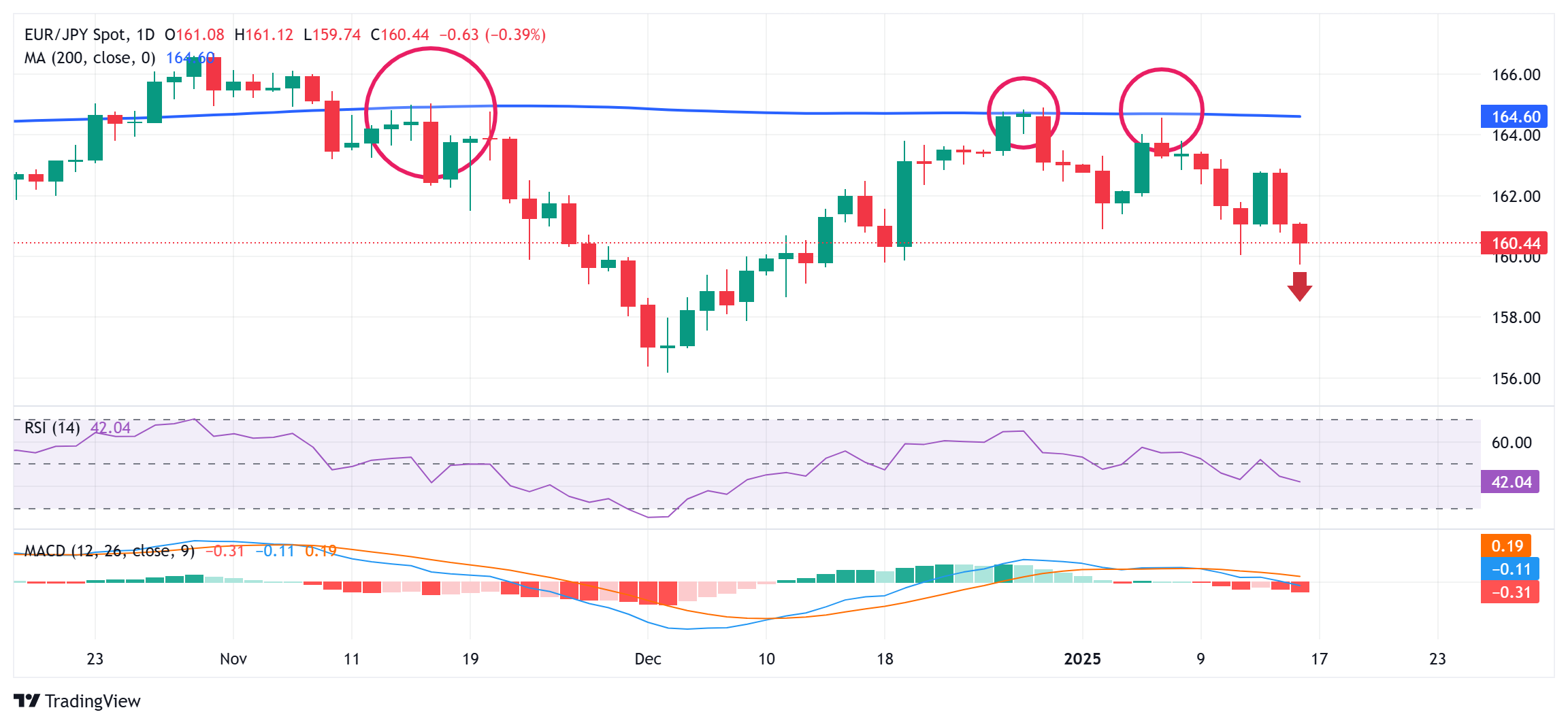EUR/JPY Price Forecast: Bounces off one-month low, still deep in the red below mid-160.00s
- EUR/JPY remains under heavy selling pressure for the second successive day on Thursday.
- The JPY continues to be underpinned by rising bets for a BoJ interest rate hike next week.
- The technical setup favors bears and supports prospects for a further depreciating move.
The EUR/JPY cross drifts lower for the second successive day on Thursday and drops to over a one-month trough, around the 159.75 region during the Asian session. Spot prices, however, rebound a few pips in the last hour and currently trade just below mid-160.00s, still down over 0.40% for the day.
The Japanese Yen (JPY) continues with its relative outperformance in the wake of a potential Bank of Japan (BoJ) interest rate hike next week. The shared currency, on the other hand, is undermined by bets for further interest rate cuts by the European Central Bank (ECB), which turns out to be another factor exerting pressure on the EUR/JPY cross. That said, the prevalent risk-on mood caps gains for the safe-haven JPY and offers some support to spot prices.
From a technical perspective, the recent repeated failures near the 164.70-164.80 region, which coincides with the 200-day Simple Moving Average (SMA), constitute the formation of multiple tops on the daily chart. Furthermore, a sustained break and acceptance below the 161.00 mark, along with the fact that oscillators on the daily chart have started gaining negative traction, suggests that the path of least resistance for the EUR/JPY cross is to the downside.
Hence, any further recovery is more likely to attract fresh sellers and remain capped near the 161.00 round figure. Some follow-through buying, however, could trigger a short-covering rally and lift the EUR/JPY cross to the next relevant hurdle near the 161.65 region, though the momentum runs the risk of fizzling out rather quickly near the 162.00 mark.
On the flip side, acceptance below the 160.00 psychological mark could drag spot prices below the 159.75 area, or the Asian session swing low, towards testing sub-159.00 levels. The downward trajectory could extend towards the 158.55-158.50 area en route to the 158.05-158.00 zone and the 157.60-157.55 region. Bearish traders might then aim to challenge the December 2024 low, around the 156.20-156.15 zone, with some intermediate support near the 157.00 round figure.
EUR/JPY daily chart

Bank of Japan FAQs
The Bank of Japan (BoJ) is the Japanese central bank, which sets monetary policy in the country. Its mandate is to issue banknotes and carry out currency and monetary control to ensure price stability, which means an inflation target of around 2%.
The Bank of Japan embarked in an ultra-loose monetary policy in 2013 in order to stimulate the economy and fuel inflation amid a low-inflationary environment. The bank’s policy is based on Quantitative and Qualitative Easing (QQE), or printing notes to buy assets such as government or corporate bonds to provide liquidity. In 2016, the bank doubled down on its strategy and further loosened policy by first introducing negative interest rates and then directly controlling the yield of its 10-year government bonds. In March 2024, the BoJ lifted interest rates, effectively retreating from the ultra-loose monetary policy stance.
The Bank’s massive stimulus caused the Yen to depreciate against its main currency peers. This process exacerbated in 2022 and 2023 due to an increasing policy divergence between the Bank of Japan and other main central banks, which opted to increase interest rates sharply to fight decades-high levels of inflation. The BoJ’s policy led to a widening differential with other currencies, dragging down the value of the Yen. This trend partly reversed in 2024, when the BoJ decided to abandon its ultra-loose policy stance.
A weaker Yen and the spike in global energy prices led to an increase in Japanese inflation, which exceeded the BoJ’s 2% target. The prospect of rising salaries in the country – a key element fuelling inflation – also contributed to the move.

